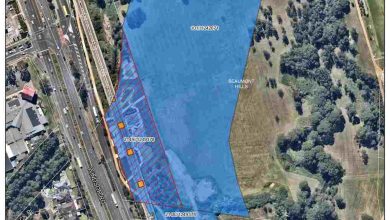Baulkham Hills Complex of Fires
On December 4th 2002 a rare solar eclipse occurred, visible to much of the southern hemisphere. On that day another significant event occurred in The Hills and Hornsby Districts that would forever change the lives of those whom were present.
Inspector Rolf Poole shares his story.
Three large bush fires started on the same day and combined to be known as the Baulkham Hills Complex of fires. This event lasted more than a week, causing significant damage to property and infrastructure from Maroota South to Glenorie, Berowra to Brooklyn, Wisemans Ferry to Kenthurst and the suburbs between. 20 Years on, the following are extracts from a recollection of the events:

A bush fire was reported in Chilvers Lane Maroota South, to be followed by an additional report of a fire at Lower Portland. Soon after the first fire fighting units arrived on scene, the Chilvers Lane fire spotted ahead of itself into the Broadwater Swamp. The tall, dead and very dry grassy reeds quickly burst into flames, fanned by very strong westerly winds. The fire made a run directly towards Old Northern Road in the vicinity of Meriden Ave Glenorie. As the fire was approaching Glenorie, a third fire was reported at Red Gables Road Kenthurst.
The Rural Fire Brigades from The Hills were all dispatched to the impacted areas, to be supported by Hornsby Ku-ring-gai, Cumberland, MacArthur, Warringah and the Blue Mountains Districts. It was evident from the rapid escalation in fire behaviour that the fires would not be contained under the weather conditions being experienced and the priority was to preserve the lives of those in their direct path. As fire crews arrived on scene they immediately located themselves at properties under direct threat.
“The fire front was seconds away. Spot fires were occurring in every piece of garden, mulch bed and in grass paddocks. The glow from the approaching fire was incredible. We couldn’t see the flames through the trees, yet there was an intense fire flare, or pre glow. Someone yelled ‘Here it comes, get ready!’.“

Myself and the late Group Officer Jim Williams met up, as we both tried to get to the trapped Glenorie crew. Making our way to extract the crew we came across two ladies whom had managed to escape the burning house just in time as the garage collapsed. All crew and the two ladies were crammed into the RFS four wheel drive car and we made a quick escape, back through the fire.
Scenes like this were repeated over and over again as crews did their best to protect those surrounded by fire. As Old Northern Road was being impacted by fire, residents and motorists became encircled.
“At some point a crew made a red call over the radio advising the fire was about to cross the road to the south of us near Mount View Road, our exit would be blocked and we would be ‘swamped in’. This meant we were surrounded on three sides by fire. We were in an unburnt pocket about 500 metres wide, that was about to be engulfed”.
At one point 15 civilians, including young children and injured fire fighters were sent into a brick constructed house and took refuge as the fire front passed. Meanwhile fire crews remained outside to protect the house.
The Chilvers Road Fire was now burning towards Arcadia, Berrilee and Berowra Waters. Crews dedicated the remainder of the day to ‘house hopping’, going from property to property in an attempt to steer the fire around dwellings and structures and protect lives.

On the 5th December 2002 the fire would spot across Berowra Creek and make a run towards the township of Cowan and later that evening another spot would impact on Berowra and Berowra Heights. I spent the following days at my home and surrounding suburbs protecting my own house and assisting neighbours, residents and fellow fire fighters.
20 years on from this event much has changed in the way we have learnt to live with fire and how we deal with large scale emergencies. Emergency alert messages and phone applications provide the community with timely advice and the actions required. Recently the new Australian Fire Danger Rating System has been introduced giving the community and fire fighters a better forecasting tools and understanding of fire behaviour.
In the 20 years we have seen similar events occur in bush fire prone areas across NSW, yet none with such impact in Greater Sydney. A timely reminder to be prepared.
– Inspector Rolf Poole District Coordinator Deputy Fire Control Officer Hornsby Ku-Ring-Gai District NSW RURAL FIRE SERVICE










